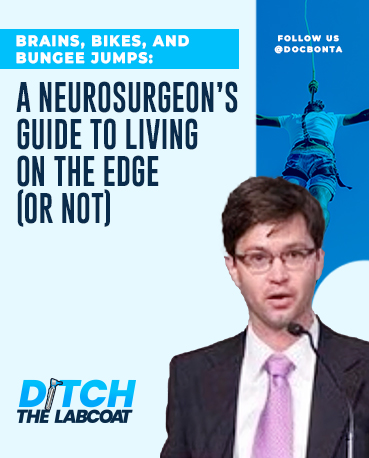Today, we took off our metaphorical lab coats (and probably should’ve strapped on some helmets) for an in-depth conversation with Dr. David Cadotte, a brilliant neurosurgeon from the University of Calgary. We covered everything from brain surgery to BMX bikes, with a few roller coasters and gainers thrown in for good measure. Whether you’re an adrenaline junkie, a risk-averse couch potato, or just someone who appreciates keeping their spine intact, this one’s for you.
Let’s dive into the conversation that made me rethink my weekend plans and probably convinced Dr. Cadotte to never attempt a backflip.
Extreme Sports: Fun Until You Can’t Feel Your Legs
It’s all fun and games until you’re hurtling down a mountain on a BMX bike at 50 mph or doing a gainer into a sketchy hotel pool. That’s how we kicked things off—discussing the spinal cord’s delicate dance with gravity and impact forces.
“You have to treat yourself like an elite athlete,” Dr. Cadotte emphasized. “If you’re not in shape, don’t have good core strength, or you’re a bit… distracted, you’re playing a dangerous game.” Essentially, if your core is more “soft marshmallow” than “steel cable,” maybe skip the cliff diving.
But what about the hidden dangers of less extreme thrills, like roller coasters? Dr. Cadotte used to love them but is now a bit more risk-averse (you know, after seeing one too many spinal injuries in his career). For most of us, they’re safe—assuming the engineers did their math right and you’re properly strapped in. But if you’re in your 40s and your neck isn’t what it used to be, maybe think twice before going for that fifth loop-de-loop.
Gainers: The Poolside Parent’s Nightmare
Let’s talk gainers. Imagine a bunch of hockey bros trying to outdo each other in a chlorinated, echoey hotel pool. They run, flip backward into the pool, and miss the cement edge by inches. Every parent’s nightmare, especially if you’re married to an ER nurse. Dr. Cadotte and I shared a collective cringe as we agreed that these moves are a one-way ticket to a spinal injury if you’re not careful.
Dr. Cadotte’s advice? “You only get to make one of these mistakes, so maybe just don’t.” I’ll be enforcing that no-gainers rule a little more strictly at my next family vacation or the next time I am the orphan parent left poolside with my son’s entire hockey team.
Motorcycle Mania and Bungee Jumping: Just Don’t
As a neurosurgeon, Dr. Cadotte has seen it all. And while many of his colleagues love the thrill of a motorcycle ride, he’s more of a “safety first” kind of guy. “I wouldn’t ride a motorcycle, bungee jump, or fly in a small plane,” he admitted.
We then went down the rabbit hole of bungee jumping injuries. While you might think it’s the cord snapping that causes the damage, it’s more mundane—but still brutal—forces, like hitting the water wrong or straining your neck from the bounce. The lesson here? If you’re going to jump, maybe stick to the trampoline park.
Listen to the podcast Episode 5 for more details
Listen Now: State of Emergency with Dr David Carr, Emergency Medicine Physician
Can’t We Just Reconnect a Severed Spinal Cord?
This one’s a biggie. If you cut the fiber optic cable to your internet, you just splice it back together and voila—Netflix is back on. But can we do the same with a severed spinal cord? I asked Dr. Cadotte if we can’t just reconnect the nerves and be on our way.
“Unfortunately, it’s not that simple,” he said. “The spinal cord is a complex network, and once it’s damaged, we don’t currently have the technology to repair it fully.” Sure, there’s hope on the horizon with things like stem cells and neural implants, but right now, there’s no magic fix for a severed cord. And if you’re thinking of hopping on a plane to a clinic promising to “fix” your spine with stem cells… maybe don’t. As Dr. Cadotte put it, “The first rule in medicine is do no harm.”
Burr Holes and Brain Drills: A Vacation Essential? 
Let’s say you’re on a mountaintop adventure, and someone in your group takes a nasty spill, leading to brain swelling. I’ve always fantasized about being the hero with the makeshift drill—like MacGyver—saving the day with an emergency burr hole to relieve pressure. So, I asked Dr. Cadotte if it’s really that easy.
His answer: A firm no. “Unless you’re equipped with an OR, a helicopter, and years of training, don’t even think about it.” If you’re ever in that kind of situation, the best advice is to get to a hospital, stat.
Listen to the podcast Episode 18 for more details
Listen Now: The Art of Making Team Excel at Trama with Andrew Petrosoniak & Chris Hicks
The Neurosurgeon’s Travel Kit: What to Pack for an Exotic Adventure
We’ve all been there—on a trip, in the middle of nowhere, and something goes wrong. I shared a story of my own Caribbean adventure where my daughter took a tumble. It had me frantically Googling the nearest hospital with a CT scanner. Dr. Cadotte’s advice? Before you go off the grid, know where the nearest medical centers are and what they can handle.
And if you’re traveling with kids? Maybe skip the adventurous locales until they’re older. Dr. Cadotte admitted that his days of risky travel are behind him, especially with young kids at home. Safety first, folks.
Neuralink, Brain Freezing, and the Future of Neurosurgery
We couldn’t wrap up without touching on the future of neurosurgery—think Neuralink, robotics, and implantable brain devices. Dr. Cadotte sees promise in using technology to improve quality of life for spinal cord injury patients. But don’t expect us to upload our brains to the cloud anytime soon. As for freezing your brain until medicine catches up. Dr. Cadotte isn’t interested. “No, I wouldn’t freeze my body,” he said. “I’m more focused on enjoying life while I’m here.”
Final Thoughts: The Brain, the Spinal Cord, and Everything In Between
In the end, it was clear that Dr. Cadotte has a deep respect for the human nervous system—whether it’s the brain, the spine, or the much-maligned peripheral nerves. From gainers in chlorine-scented pools to the promise of neural implants, we covered it all.
So, next time you’re tempted to ride that roller coaster, do a backflip, or sign up for a bungee jump, just remember: you’ve only got one spine, and Dr. Cadotte will be the first to tell you it’s not as easy to fix as a fiber optic cable.
Until next time, stay safe, treat your body like the elite athlete you are (or wish you were), and maybe keep both feet on the ground.

